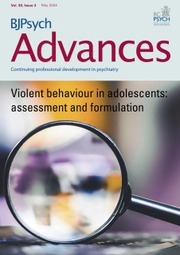No CrossRef data available.
Article contents
Common and specific factors in psychological treatment of personality pathology
Published online by Cambridge University Press: 02 December 2024
Summary
Cognitive–behavioural therapy (CBT) has been widely used for a broad range of mental health problems for several decades and has been researched extensively. Its techniques are relatively easy to learn and follow in treatment protocols. Many new CBT-based psychotherapies have been developed that go further than traditional CBT, some specifically addressing personality disorders. These so-called third-wave approaches target emotional responses to situations by using strategies such as mindfulness exercises and acceptance of unpleasant thoughts and feelings (observing thoughts as ‘from afar’). In this article, we discuss the historical context of these therapies, dissect common and specific factors in some treatment modalities often used to treat personality disorders, and suggest potential future directions for research and treatment.
- Type
- Article
- Information
- Copyright
- Copyright © The Author(s), 2024. Published by Cambridge University Press on behalf of Royal College of Psychiatrists




eLetters
No eLetters have been published for this article.